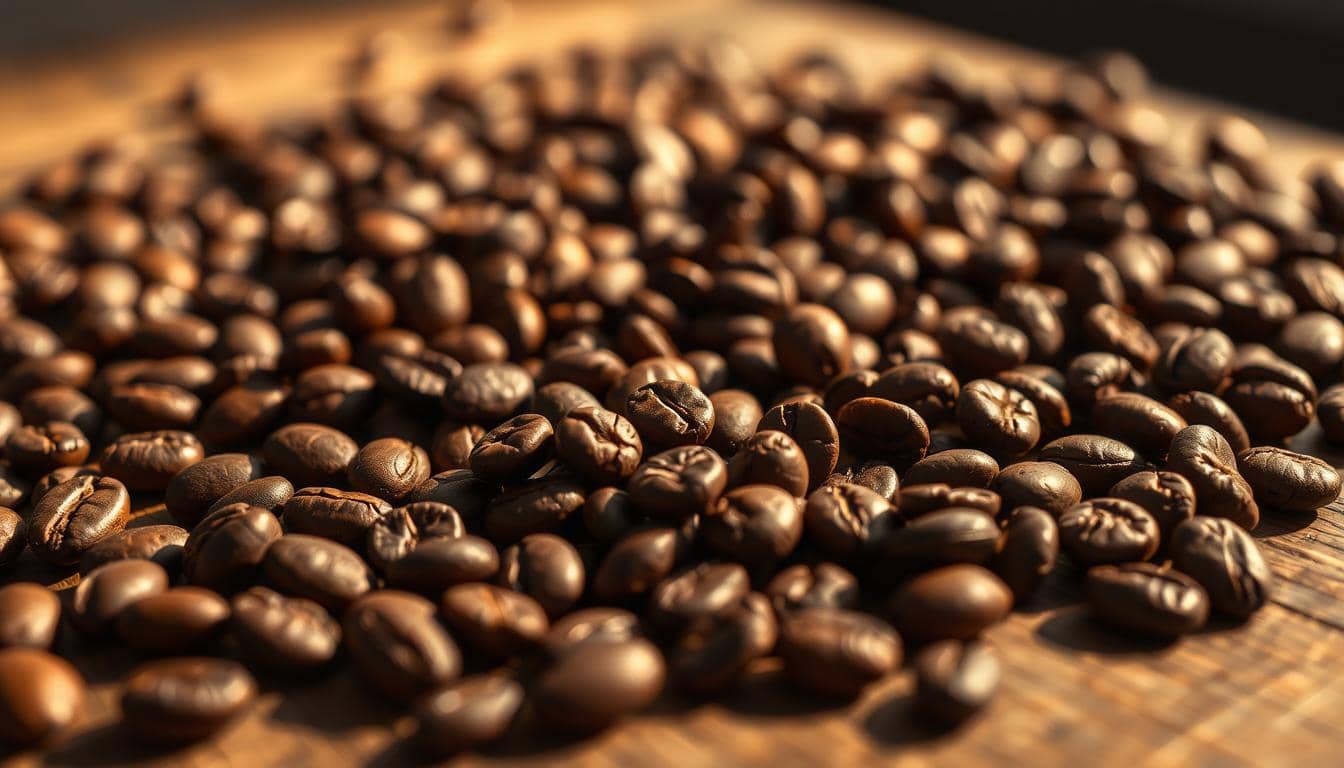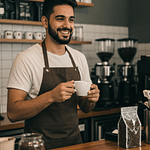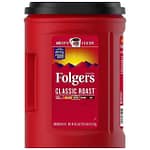Did you know the average American drinks nearly 300 milligrams of caffeine every day? That’s enough for over three cups of regular coffee. But now, half-caff coffee is gaining popularity. It has 40–70 mg of caffeine per cup, offering a milder buzz without losing flavor.
Half-caff coffee is a 50-50 blend of regular and decaf beans. It gives you half the caffeine of a regular cup. Brands like Fabula make sure each batch is safe, with over 350 checks and USDA Organic certification. They use the Swiss Water Process, removing 99.9% of caffeine but keeping the taste rich.
So, why are people switching to half-caff? They want coffee’s benefits like better focus and energy without the crash. Research shows moderate caffeine, like in half-caff, can lower heart risks. It’s also gentler on the stomach than dark roasts. And it helps users stay within safe caffeine limits without giving up coffee.
Key Takeaways
- Half-caff coffee offers 40–70 mg of caffeine per cup—half of regular coffee’s 90 mg.
- It combines 50% regular beans with 50% decaf for balanced flavor and energy.
- Methods like Swiss Water ensure taste stays rich while removing 99.9% of caffeine.
- Lower caffeine aligns with FDA guidelines, reducing risks like anxiety or sleep issues.
- It’s perfect for those wanting coffee’s benefits without over-caffeination.
Introduction
The Middle Ground in Coffee Culture
Before, coffee was either full-strength or decaf. Now, we have half-caff blends. These mixes have equal parts caffeinated and decaf beans. They offer a balance between flavor and caffeine control.
People want more than just yes or no choices. They’re not giving up coffee. Instead, they’re choosing low caffeine coffee as a better option. Brands are listening. Big names are adding half-caff options to their menus.
In the next parts, we’ll dive into how these blends are made. We’ll look at their benefits and where to find the best ones. Whether you’re cutting back or just curious, this guide is for you.
What Is Half-Caff Coffee?
Half-caff coffee is made by mixing regular and decaf beans. This way, you get a coffee that’s not too strong but still tastes great. It has about half the caffeine of regular coffee, making it perfect for those who want a milder taste.
- Beans: Colombian La Falda (regular) paired with Madre Laura Decaf, grown at 1,450–2,000 meters in Huila and Antioquia.
- Roast: Medium roast to highlight natural sweetness and acidity.
- Flavor: Notes of pancake syrup, orange, dried fig, and pecan with a velvety mouthfeel.
Why People Are Choosing Half-Caff
More people are looking for caffeine reduction in their coffee. They want to enjoy coffee without too much caffeine. This is for better sleep, focus at work, or health during pregnancy. It shows that flavor and wellness can go together.
“Many healthcare providers recommend limiting caffeine intake during pregnancy,” says the American College of Obstetricians and Gynecologists. Their guidelines highlight caffeine reduction as a key step for expecting mothers.
So, why is half-caf so popular? Here are some reasons:
- Health-conscious choices: Half-caf has 50% less caffeine (47.5mg per cup) but still tastes great. It’s good for pregnant women, those with insomnia, and people with heart issues.
- Work-life harmony: Remote workers say they feel better without the afternoon crash. One parent said, “I can drink this all day without feeling wired at bedtime.”
- Quality without compromise: Brands like Kicking Horse (since 2012) and Savorista (People’s Choice Award winner) show you can reduce caffeine without losing flavor. Swiss Water’s decaf process keeps the coffee’s acidity and aroma.
Health Benefits of Reducing Caffeine
For those looking for health-conscious coffee, half-caff is a great choice. It offers a balance between enjoying coffee and staying healthy. Many of us love coffee but don’t want the jitters or trouble sleeping. Half-caff lets you enjoy the taste without too much caffeine.
“Reducing caffeine doesn’t mean sacrificing flavor—just smarter choices.”
Research shows some benefits:
- 1-2 cups daily may lower heart failure risk by supporting stable heart function.
- Women who drink 2-3 cups daily may reduce dementia risk by 26% compared to non-drinkers.
- Lower caffeine intake aligns with FDA guidelines, keeping consumption under 400mg daily.
Half-caff is perfect for a health-conscious coffee lifestyle. Dark roast blends, for example, reduce DNA damage while keeping the flavor rich. Pregnant individuals or those managing anxiety can enjoy their morning cup without feeling overstimulated. Even small changes matter: swapping one fully caffeinated cup for half-caff cuts intake by 50mg instantly.
Half-caff is a middle path—enjoying coffee’s benefits without overdoing it. It can lead to better sleep and fewer midday crashes. Remember, every sip counts when focusing on long-term health.
How Half-Caff Coffee Is Made
Every cup of half-caff coffee is a mix of old ways and new ideas. It begins with blending regular and decaf beans in equal parts. This creates a 50/50 mix, cutting caffeine in half compared to regular coffee.
But making this blend is more than just mixing beans. It’s about finding flavors that go well together.
Decaffeination is key. Most makers use the Swiss Water Process. This method removes over 97% of caffeine without chemicals, keeping the bean’s natural taste.
Roasters like Kicking Horse and Savorista are experts at this. They offer blends like Kicking Horse’s “Half Ass” and Savorista’s award-winning single-origin options.
- Step 1: Select beans with compatible flavor profiles for caffeinated and decaf portions.
- Step 2: Decaffeinate beans using Swiss Water Process for purity.
- Step 3: Roast and blend beans to balance roast levels, as decaf beans roast differently.
Roasters adjust roasting times for decaf beans since they absorb heat differently. This keeps the taste and aroma consistent. The result is a coffee with half the caffeine but full flavor.
This is perfect for those watching their caffeine intake. It’s great for expecting parents or anyone easing into mornings.
Where to Buy the Best Half-Caff Coffee
Looking for low caffeine coffee can be tough with so many brands out there. To find great coffee, look for roasters who focus on quality over quick sales. Important things to check are how they decaffeinate, where they get their beans, and if the taste is consistent.
- Look for the Swiss Water Process label—this chemical-free method preserves natural flavors.
- Check roast levels: medium roasts balance acidity and bitterness best in half-caff blends.
- Choose organic certified beans when possible for purity and taste.
- Prefer direct-to-consumer brands or local roasters for fresher batches.
Specialty brands like Kauai Coffee mix Swiss Water Decaf with top-quality Arabica beans for a smooth taste. Two Chimps Coffee uses sugarcane decaffeination, giving their Half-Caff a chocolatey flavor. Online stores like TrueStart have instant low caffeine coffee packets for easy use on the go.
Local coffee shops usually have small-batch half-caff blends. But, big chains might not be as careful. Always read reviews and look for certifications like USDA Organic or Fair Trade. If you’re unsure, ask the baristas at specialty cafes. They can tell you which brands avoid harsh chemicals like methylene chloride.
Whether you like beans or single-serve pods, choose brands that are open about their process. The best low caffeine coffee comes from roasters who share how they decaffeinate and where they get their beans. Try different samples and buy from brands that match your taste.
How to Brew Half-Caff Coffee at Home
Learning to make half-caff coffee at home is easy. It lets you enjoy your favorite drink while cutting down on caffeine reduction. Start with pre-blended options like Two Chimps Coffee’s “Two Horned Unicorn.” It mixes Brazilian beans with sugarcane-decaffeinated Colombian beans. This blend keeps bold flavors but cuts caffeine by 50%.
Use your usual brewing method—drip, French press, or pour-over—with these tips:
- Grind beans just before brewing to preserve freshness.
- Heat water to 195–205°F for optimal extraction.
- Try a slightly finer grind for espresso to enhance flavor clarity.
Try making your own blend by mixing regular and decaf beans in equal parts. Adjust the ratio if you want more caffeine. For example, mixing a bold regular roast with Swiss Water Process decaf keeps the flavor rich without harshness.
Be patient and make small changes. Keep track of how different ratios affect your energy. Even a 50/50 mix cuts caffeine to about 50mg per 8-ounce cup. This matches FDA guidelines for moderate intake. Pair this with careful brewing to balance flavor and caffeine reduction.
The Future of Half-Caff Coffee
Coffee trends are moving towards customization and wellness, with half-caff leading the way. We can expect new brewing methods and blends. Here’s what’s coming:
- More brands are adopting it as a staple: Over 25% of U.S. roasters now offer half-caff blends. It’s no longer just a niche option.
- Flavor-first decaf tech: New methods like sugarcane-based decaffeination keep the taste. This makes blends like Vigilante’s Half Caff Dark Roast (with notes of orange and dark chocolate) really stand out.
- Personalized caffeine control: Some brands now offer “quarter-caff” or “three-quarter-caff” options. This lets drinkers adjust their caffeine level to their liking.
- On-the-go convenience: Half-caff cold brew cans and bottled lattes are hitting stores. They’re right next to traditional coffee drinks.
Today’s coffee trends show a desire for balance. Over 30% of drinkers choose half-caff to manage caffeine without losing flavor. With 60% of consumers focusing on health, brands like Vigilante are responding. They offer blends like 50/50 Colombian and Brazilian beans, roasted medium for a creamy feel.
We can expect more creativity: lower-caffeine espresso shots, half-caff roasts from different regions, and subscription services based on caffeine needs. The focus is on quality. This way, drinkers can enjoy every sip without the crash.
Conclusion: Should You Make the Switch?
Choosing between regular and half-caff coffee depends on your needs. Half-caff is perfect for those who want to enjoy coffee but are sensitive to caffeine. It’s a trend that fits with today’s desire for mindful drinking.
Weighing the Benefits and Finding Your Perfect Balance
Health-conscious coffee lovers look for ways to enjoy their coffee without too much caffeine. Half-caff has 50% caffeine, fitting within the USDA’s daily limit of 400 mg. A single 8-ounce cup of half-caff has about 47.5 mg caffeine, offering a good balance.
Research shows that even small cuts in caffeine can help prevent chronic diseases. For example, a 2021 study found that decaf drinkers had a 20% lower risk of liver problems compared to non-drinkers. On the other hand, regular coffee can improve memory in older adults, as a 2020 study showed.
Trying half-caff means exploring different blends from brands like Starbucks or local roasters. It might cost more than regular coffee, but it’s worth it for those who value moderation. It’s great for parents, athletes, or anyone who wants to enjoy coffee without feeling too jittery. The aim is to find a balance that energizes your day without overwhelming you.
FAQ
What exactly is half-caff coffee?
Half-caff coffee is a mix of regular and decaf beans. It has about half the caffeine of regular coffee. This blend gives you a taste of coffee without too much caffeine.
Why is half-caff coffee becoming so popular?
More people want coffee that fits their lifestyle. They might want less caffeine for health reasons or to avoid jitters. Half-caff is a perfect choice for those who love coffee but don’t want too much caffeine.
What are the health benefits of switching to half-caff?
Half-caff can improve sleep and reduce anxiety. It also gives you steady energy and might ease digestive issues. Many find it easier to switch to half-caff than to quit caffeine cold turkey.
How is half-caff coffee made?
Making half-caff coffee is an art. It involves blending regular and decaf beans carefully. The Swiss Water Process is preferred for its flavor preservation. Roasters also focus on the right roast for each bean.
Where can I find the best half-caff coffee?
Look for specialty coffee roasters and brands that highlight their decaf methods. Two Chimps Coffee and TrueStart Coffee are great options. You can also try local cafés and online shops for fresh half-caff.
Can I brew half-caff coffee at home?
Yes, you can! Use pre-blended half-caff beans for the best taste. Brew it with your favorite method, like drip or French press. Or mix regular and decaf coffee for a custom blend.
What does the future hold for half-caff coffee?
Half-caff’s future is promising. Specialty roasters are focusing more on it. We’ll see new decaf methods and more cafes offering half-caff. It’s all about meeting the demand for health-conscious coffee.










